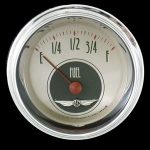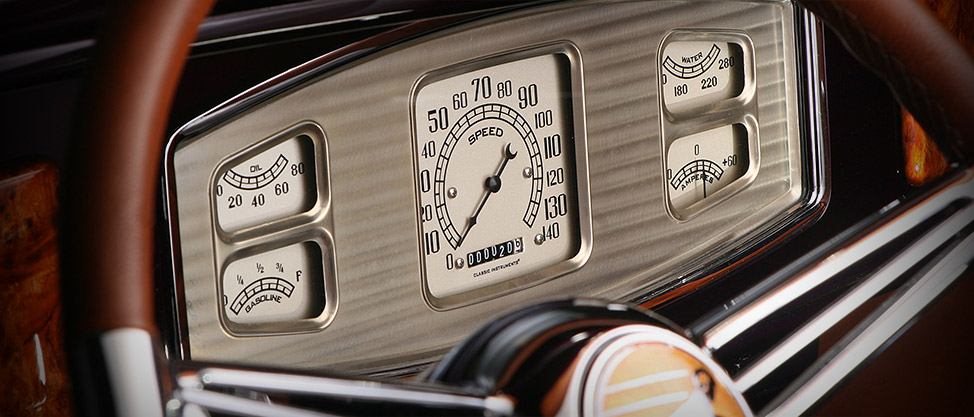Top Ways to Mess Up Your Gauges
We all have a set of gauges right in front of us every time we get into our hot rods. Modern gauges are generally quite reliable but like many other systems, there are ways we can mess up their installation. We have seen guys chase nonexistent overheating or low oil pressure problems simply because the gauge was delivering an inaccurate reading. Connecting a temporary mechanical gauge made it clear that the electrical gauge was wrong. A simple error using Teflon tape as a sealing precaution also prevented a full grounding of the sender which was delivering a low voltage signal.
John McLeod has turned Classic Instruments into a hot rodding industry stand out. John also heads SEMA’s Hot Rod Industry Alliance (HRIA). He graciously agreed to supply us with some advice on how to avoid common problems he’s seen in their technical support department. Since many of these tips will apply to other brand gauges, we’ll cover these tips for general use on any brand of gauges.
 Putting Teflon tape on sender threads.
Putting Teflon tape on sender threads.
Classic Instruments temperature and oil pressure senders require a ground which is made through the threads to the engine. Using a lot of sealer or Teflon tape on the threads of the sender will cause a bad or no ground connection. This will make the gauge read lower or not at all. The senders have pipe threads which are tapered and self-sealing. In most cases, a sealant is not necessary in order to have a leak-free installation.
Connecting multiple gauges / devices to a single sender.
- Classic Instruments senders are made to connect to only one Classic Instruments gauge. Connecting more than one device to the sender could cause the gauge to malfunction or work inaccurately.
- If more than one device (i.e. computer or electric fan) requires a temperature signal or pressure signal, two separate senders (specific to those devices) are required.
- Classic Instruments 3-wire 16-pulse signal generators are an exception. Since these signals are powered, it is possible to use this signal for a cruise control or lockup as well. The 16 pulse signal generators produce 16,000 pulses per mile with a 12V square wave.
 Installing the fuel level sender without first testing it with the fuel gauge while the sender is still outside of the tank.
Installing the fuel level sender without first testing it with the fuel gauge while the sender is still outside of the tank.
- It’s a good idea to test the fuel gauge with the sender before the sender is mounted in the tank. This will ensure the sender operates on the resistance range for which the gauge was made. Since it is often difficult to get at the sender once installed in the tank, this could be a real time saver.
- If possible, install an access panel above the fuel sender so if anything happens to the sender or if you want to change the sender, you won’t need to drop the tank to do it.
- We will add that Classic Instruments now offers a Fuel Sender Unit, which can match any brand of fuel level sender resistance rating to their gauges.
Mounting a 3 3/8-inch and 4 5/8-inch speedometer into a tight dash before performing a calibration.
- Classic Instruments 3 3/8-inch and 4 5/8-inch have a row of dip switches on the back that are used to calibrate the speedometer. You can save time and energy (and the possibility of accidentally causing damage to your dash) by performing a speedometer calibration before permanently mounting the speedometer in the dash. Leaving some slack in the wires to the speedometer will allow you to easily remove the speedometer from the dash, adjust the dip switches, and then do the final placement of the speedometer back into the dash.
Using other manufacturer’s temperature or oil pressure sending units
- Classic Instruments’ temperature and oil pressure gauges are made to work with very specific resistance range senders. Most other manufacturer’s sending units operate at different resistance ranges and will cause Classic Instruments’ gauges to read inaccurately. For example, some OEM GM oil pressure senders will cause a Classic Instruments oil pressure gauge to read backward
Using thread adapters to get a Classic Instruments temperature sender to fit in your intake manifold.
- Classic Instruments carries a variety of sizes in temperature senders. It is important to use the correct size sending unit in order to insure the probe at the end of the sender is fully submerged in the engine coolant when installed. When a thread adapter is used, the sender probe sometimes does not go as far into the intake manifold and is not submerged in the coolant. This could cause the probe to measure coolant vapor temperature which is significantly hotter than the actual coolant in the engine and cause the temperature gauge to read high.
Installing the temperature sender in the engine head.
- Installing a temperature sender in the head of an engine could cause the temperature gauge to read higher than the actual temperature of the coolant. This is because of the close proximity of the sender with the exhaust manifold. The exhaust manifold is much hotter than the coolant of the engine and this heat will raise the temperature of the sending unit.
- In some engines, an LS engine, for example, the only place to install a temperature sender is in the head. In these cases, try to shield the sender as much as possible from other heat sources — such as exhaust.
Mounting an SN74Z speed signal interface module in a location where the status LED’s are not visible.
- The SN74Z has a LED display and LED indicator that aid you with the calibration process and during troubleshooting. Temporarily mount the SN74Z in a location where it can be seen during the speedometer calibration. Once the calibration is complete, the module could be permanently mounted in a new location that may or may not be visible. Disconnecting the SN74Z will not cause it to lose the latest calibration.

Using the “real time” calibration method the first time you calibrate a pushbutton speedometer.
- The “real time” calibration method is designed for fine-tuning a speedometer that is close to being accurate. The speed changes at a very slow rate with this method and could take a long time to change the speed reading significantly. This could also cause an inaccurate accumulation of mileage on the odometer.
- Classic Instruments recommends performing the initial speedometer calibration using the “instant calibration” or “auto calibrate” method. These methods do not add any mileage to the odometer and are very accurate. If, after the initial calibration, the speedometer is not completely accurate, the “real time” method is preferable to fine tune the calibration.
- You can also verify speedometer readings by comparing the gauge to your GPS while driving at a constant speed on a straight section of road. Or use the old way of counting interstate mile markers for at least a 20-mile stretch, then comparing that to your odometer to find a percentage error. Mechanical gear change boxes are available for cable drive speedos, as are different trans output shaft gears that can best be sourced at a dealer parts counter.
Bottom line: there’s no reason to have to deal with inaccurate gauges when the health of your engine, your driving record, and your wallet are at risk!





